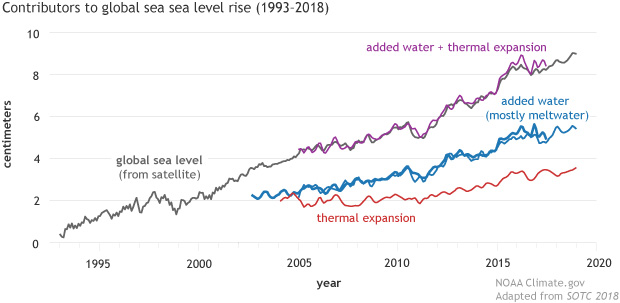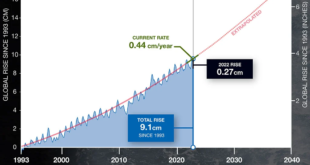 The Climage.gov article Climate Change: Global Sea Level by Rebecca Lindsey (1/25/2021) provides a nice overview of rising sea levels. It is easy to forget that thermal expansion of water is a significant contributor to sea level rise.
The Climage.gov article Climate Change: Global Sea Level by Rebecca Lindsey (1/25/2021) provides a nice overview of rising sea levels. It is easy to forget that thermal expansion of water is a significant contributor to sea level rise.
Global mean sea level has risen about 8–9 inches (21–24 centimeters) since 1880, with about a third of that coming in just the last two and a half decades. The rising water level is mostly due to a combination of meltwater from glaciers and ice sheets and thermal expansion of seawater as it warms.
To estimate how much of the observed sea level rise is due to thermal expansion, scientists measure sea surface temperature using moored and drifting buoys, satellites, and water samples collected by ships. Temperatures in the upper half of the ocean are measured by a global fleet of aquatic robots. Deeper temperatures are measured by instruments lowered from oceanographic research ships.
To estimate how much of the increase in sea level is due to actual mass transfer—the movement of water from land to ocean—scientists rely on a combination of direct measurements of melt rate and glacier elevation made during field surveys, and satellite-based measurements of tiny shifts in Earth’s gravity field. When water shifts from land to ocean, the increase in mass increases the strength of gravity over oceans by a small amount. From these gravity shifts, scientists estimate the amount of added water.
The are other graphs in the article and links to data (note the link at the end of the article).
